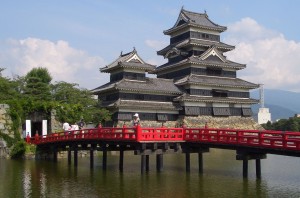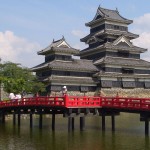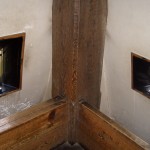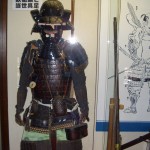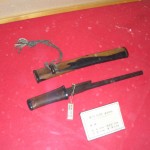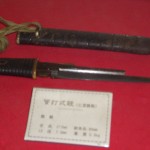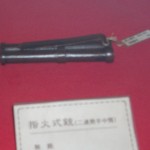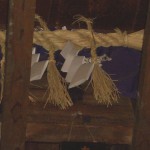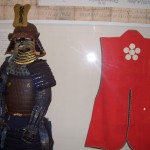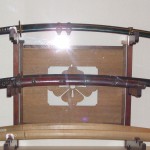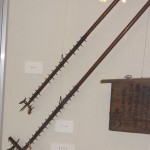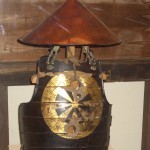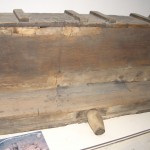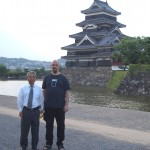Matsumoto Castle and museum
Matsumoto Castle and Firearms Museum.
In years past when one studied koryu the skills learned would include ‘battlefield fortifications’ and other defensive tactics. Sometimes defending ones lord would require knowledge of defensive fortifications as well as tactics and martial skills. On a recent visit to Japan to study Iaido I was lucky enough to be shown round Nagano prefectures Matsumoto castle and firearms museum by Mr Seiji Ikegami. (pic 18) It will be of interest to many Martial artists because of the original defensive features of the castle, as well as the unusual weapons in the museum. Most peoples knowledge of Japanese castles is confined to the post war concrete Osaka castle. Matsumoto castle differs from this in so far as it is largely original.
It was originally a fort from the Sengoku jidai(age of warring states) under the Ogusawara family. The Ogasawara name is known to students of iaido as the seiza kneeling position was adopted and used in Musoshindenryus’ Omori ryu after the master studied the Ogasawara school of etiquette.
As a castle it passed from the Takeda family to the Togugawa Ieyasu shogunate. The famous general Toyotomi Hideyoshi then placed it under the control of the Ishekawa Norimasa family. The founding date of the castle’s donjon(keep) is 1590 by Ishikawa Kazamasa when the distinctive ‘NoZura-zumi’ foundations were laid-pictured in picture 11.
Picture 1 shows the impressive keep –often called a ‘crows keep’ because of its black colour and the layered wings; and the larger of the gatehouses. It is interesting to note that from the outside there are five floors, whilst on the inside there are six floors. One floor was secret and used to conceal the lord and his retainers. Although the hidden floor has a low ceiling the main floor where the lord resided had a high ceiling to allow the samurai to use their long katana against assasins who would invariably be armed with shorter swords! Picture 2 shows the firearms slits which crisscross the area above the gatehouse whilst pic 3 shows some of the defensive arrow gratings. There are approximately seventy of these defensive slots. It is interesting that the gatehouse is only able to be defended against the mote side and not the keep side! There are also eleven stone dropping slots above the walkways between each level which make the castle easy to defend. Picture 10 shows the thin steep stairway which it was very difficult to attack up. It is hard to just walk up with the stairs being about two feet apart!-I knoiw this from personal experience! This defensive feature reminds me of the way that Scotland’s round towers of old had the spiral staircase going round in the direction to favour the defender! Imagine having to fight your way up such a staircase whilst being cut and stoned from above!
Picture 9 shows some items from the roofs Shinto shrine which were said to have kept the castle safe for so long. Pic 17 shows part of the castles ancient forge.
Pictures 4, 12, and 16 show some of the armours from the museum. If you look closely at pic 16 you will see the bullet holes in the armour. Pic’s 13 and 14 show some of the Katanas and a bow from the museum, whilst picture 15 shows an ingenious device known as a Sodegarami used for ensnaring a Samurais clothing in order to subdue him. These devices were also used by the police to capture ‘uncooperative’ samurai!
Pictures 5, 6, 7, and 8 show a variety of stealth weapons found around the castle. These are mainly firearms disguised as jutte(truncheons) or pistols disguised as tanto. It is interesting to note the existence of such sneaky weapons in feudal Japan as well as throughout the Western world!
I enjoyed my visit to Matsumoto castle. The defensive features of the castle, and interesting weapons in the museum made the trip worthwhile. If anyone does visit Matsumoto in Nagano there is also a less impressive modern castle at Shimosuwa called Takashima castle. Thanks to Mr Ikegami for guiding me round this impressive castle.
In years past when one studied koryu the skills learned would include ‘battlefield fortifications’ and other defensive tactics. Sometimes defending ones lord would require knowledge of defensive fortifications as well as tactics and martial skills. On a recent visit to Japan to study Iaido I was lucky enough to be shown round Nagano prefectures Matsumoto castle and firearms museum by Mr Seiji Ikegami. (pic 18) It will be of interest to many Martial artists because of the original defensive features of the castle, as well as the unusual weapons in the museum. Most peoples knowledge of Japanese castles is confined to the post war concrete Osaka castle. Matsumoto castle differs from this in so far as it is largely original.
It was originally a fort from the Sengoku jidai(age of warring states) under the Ogusawara family. The Ogasawara name is known to students of iaido as the seiza kneeling position was adopted and used in Musoshindenryus’ Omori ryu after the master studied the Ogasawara school of etiquette.
As a castle it passed from the Takeda family to the Togugawa Ieyasu shogunate. The famous general Toyotomi Hideyoshi then placed it under the control of the Ishekawa Norimasa family. The founding date of the castle’s donjon(keep) is 1590 by Ishikawa Kazamasa when the distinctive ‘NoZura-zumi’ foundations were laid-pictured in picture 11.
Picture 1 shows the impressive keep –often called a ‘crows keep’ because of its black colour and the layered wings; and the larger of the gatehouses. It is interesting to note that from the outside there are five floors, whilst on the inside there are six floors. One floor was secret and used to conceal the lord and his retainers. Although the hidden floor has a low ceiling the main floor where the lord resided had a high ceiling to allow the samurai to use their long katana against assasins who would invariably be armed with shorter swords! Picture 2 shows the firearms slits which crisscross the area above the gatehouse whilst pic 3 shows some of the defensive arrow gratings. There are approximately seventy of these defensive slots. It is interesting that the gatehouse is only able to be defended against the mote side and not the keep side! There are also eleven stone dropping slots above the walkways between each level which make the castle easy to defend. Picture 10 shows the thin steep stairway which it was very difficult to attack up. It is hard to just walk up with the stairs being about two feet apart!-I knoiw this from personal experience! This defensive feature reminds me of the way that Scotland’s round towers of old had the spiral staircase going round in the direction to favour the defender! Imagine having to fight your way up such a staircase whilst being cut and stoned from above!
Picture 9 shows some items from the roofs Shinto shrine which were said to have kept the castle safe for so long. Pic 17 shows part of the castles ancient forge.
Pictures 4, 12, and 16 show some of the armours from the museum. If you look closely at pic 16 you will see the bullet holes in the armour. Pic’s 13 and 14 show some of the Katanas and a bow from the museum, whilst picture 15 shows an ingenious device known as a Sodegarami used for ensnaring a Samurais clothing in order to subdue him. These devices were also used by the police to capture ‘uncooperative’ samurai!
Pictures 5, 6, 7, and 8 show a variety of stealth weapons found around the castle. These are mainly firearms disguised as jutte(truncheons) or pistols disguised as tanto. It is interesting to note the existence of such sneaky weapons in feudal Japan as well as throughout the Western world!
I enjoyed my visit to Matsumoto castle. The defensive features of the castle, and interesting weapons in the museum made the trip worthwhile. If anyone does visit Matsumoto in Nagano there is also a less impressive modern castle at Shimosuwa called Takashima castle. Thanks to Mr Ikegami for guiding me round this impressive castle.
- Matsumoto castle
